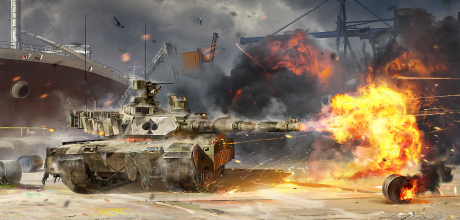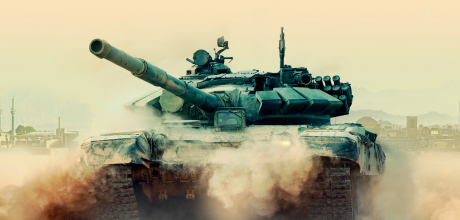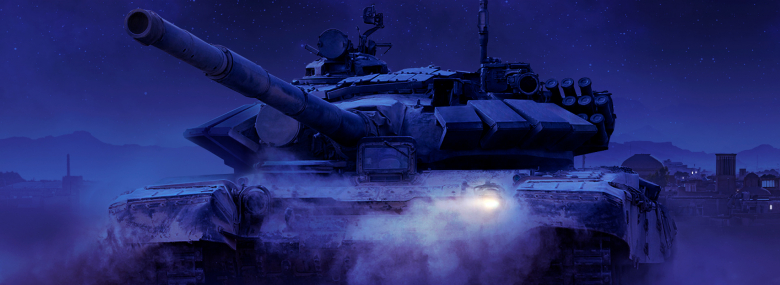
Commanders!
In the last article, we discussed the ill-fated AMX-50 program that left the French military of the 1950s with only one option – to purchase the obsolete M47 Patton tanks the Americans were trying to sell. Naturally, the best way to get rid of obsolete equipment is to sell it to your allies, which is why hundreds of these tanks ended in France, Italy, Spain and West Germany.
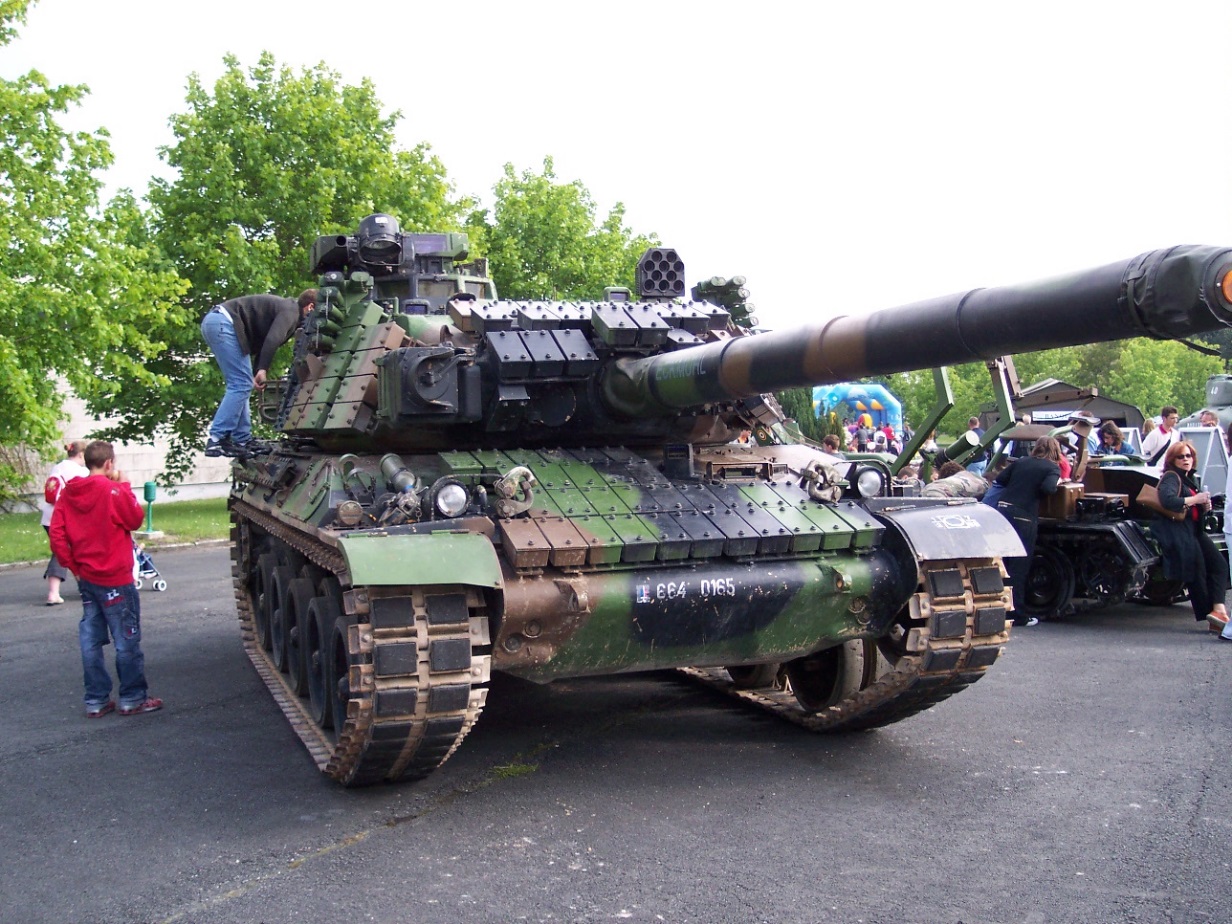
AMX-30B2 Brenus
But, contrary to what some doomsayers had been preaching at the time, the purchase of foreign equipment did not mean the end of the French school of tank design. Quite the contrary – in the second half of the 1950s, France and West Germany joined forces and embarked on a journey that would end on the German side with Leopard 1 and on the French side with a tank called AMX-30.
The cooperation began in 1956 with the goal of replacing the M47. West Germany and France were, naturally, aware of its obsolescence and strove to replace it as soon as possible, ideally with something domestically produced. The project was referred to as “Standartpanzer” or “Europa-Panzer” (even on the French side).

French M47 in Algiers with its commander, future president Jacques Chirac, 1956
The basic idea behind the project was that no amount of steel armor would be able to protect the tank against modern anti-tank HEAT shells and guided missiles that started to appear in the mid-1950s. France’s own SS.11 ATGM, which first appeared in 1956, was a large monster, capable of defeating 600mm of RHAe, something the steel-armored tanks of the era were not capable of resisting. Therefore, it made sense to add only enough armor to protect the future tank’s crew against heavy machineguns and basic autocannons. In 1957, the requirements for the tank were issued accordingly:
- Limited size (3.15m width, 2.15m height) in order to make it a small target
- Firepower consisting of a 105mm cannon
- Air-cooled gasoline engine with the power to weight ratio of at least 30 hp/t
- Torsion bar suspension with hydraulic shock absorbers
- Operational range of at least 350km
Later that year, Germany and France agreed to build prototypes based on the requirements independently, which turned out to be the beginning of a split between Germany and France. Italy formally joined the program in 1958, but had no design bureaus capable of producing a variant of their own and their part of the program went nowhere, even though some (classified) paper designs are rumored to exist. Additionally, Italy was legally prohibited from designing tanks following the outcome of the Second World War, so any such design would be kept in strict secrecy. This ban was lifted in the early 1970s (presumably, 1973). It can be therefore said with certainty that any Italian designs that pre-date 1973 and were “unveiled” relatively recently are completely made up.
Needless to say, politics would play a major role in the program. The Germans were the “black sheep” of Europe at that time – with the resolution of the most devastating conflict in human history mere 15 years away, many French politicians viewed their now allies against communism with distrust. A major political issue emerged in the late 1950s when de Gaulle’s France refused to share nuclear weapons technology with Italy and West Germany, ostensibly not to anger the Americans and the British. In reality, the French just wanted to remain the nuclear hegemon of mainland Europe, a fact which did not escape the Germans. As a result, the Franco-German cooperation started to receive some quite serious cracks.
While in Germany there were two teams working on the future Leopard seriously, in France, essentially only one company was capable of handling such a major project – Atelier de Construction d'Issy-les-Moulineaux, better known under the acronym AMX. The person in charge of the project was initially the AMX director himself, General Joseph Molinié, an old tank designer and a veteran of the company. He joined AMX in 1936, became a director in 1945 and would retire in 1961.
Based on the 1957 requirements, AMX built two prototypes in between 1960 and 1961. These early prototypes were more than a little inspired by the Soviet T-54, especially in the turret area. The oscillating turret concept was abandoned due to its numerous flaws – true, it was a success on the AMX-13, but for a MBT, it was just too gimmicky. Instead, the tank had a conventional cast turret. It was very round (especially in the rear) with a large mantlet in the front.
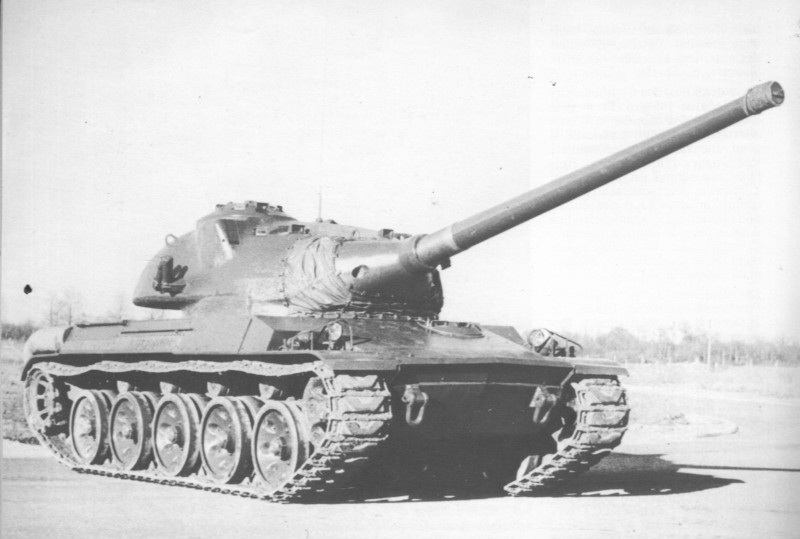
AMX-30 early prototype
It was quite thin too – even though the frontal hull was well-sloped, the crew was only reliably protected from 20mm autocannon fire. On the other hand, that made the tank quite light with its weight reaching about 32.5 tons. The prototypes were powered by a Sofam 12 GS 720hp gasoline-powered 12-cylinder engine and had an excellent power to weight ratio of 22 hp/t (considerably better than the Patton series) and the maximum speed of 65 km/h.
The engine, however, was a source of contention because the Americans and the Germans were both moving towards diesels (or, in German case, multi-fuel engines) in an effort to increase the ranges of their tanks – after all, in the case of the U.S. M60 tank, when switching from the older AV-1790 series to the AVDS-1790 diesels, its fuel economy increased as much as by 60 percent.
The French had been using gasoline engines for a long time for logistics reasons (in peace-time, gasoline is easier to obtain than diesel and the tanks could basically run on civilian grade fuel) but the advantages of diesels could not be denied. Unfortunately, they did not have a suitable diesel tank engine at hand, which was why the French division of Hispano-Suiza was tasked with designing a building one.
Another very interesting part of the design was the firepower. The 1957 requirements called for the 105mm caliber, which often leads to the false assumption that the French were planning to adopt the British L7 like the Germans did. In reality, the French had their own L/56 105mm rifled cannon called CN-105 F1, designed by a company called at that time “Atelier de construction de Bourges.” The company got later renamed to EFAB and, in 1990, it became a part of the GIAT group and finally, in 2007, a part of Nexter – that’s why you sometimes see the French gun being called by the GIAT CN-105 name (or variants thereof). What makes the gun visually interesting is the lack of a bore evacuator (the distinctive “hump” on the barrel) since the gun used a different system to get rid of gasses (compressed air flushes).
The gun wasn’t all that special – what made it really interesting was the ammunition. Simply put, the French took a look at the latest kinetic versus HEAT ammunition developments and decided to produce a hybrid of sorts – a HEAT round with high muzzle velocity in order to make it accurate at long distances – after all, HEAT rounds were very effective against steel-only Soviet tanks. The problem with that approach was the rifled barrel of the gun that made the shell rotate. Normally, that would be a good thing, as that’s how rifled gun shells are stabilized. Unfortunately, rotation also has very negative effect on HEAT warheads because when it spins, the centrifugal force disperses the jet of metal that this type of shell uses to penetrate enemy armor.
What the French did was quite clever – they separated the shell into two layers, divided by ball bearings. The outer layer of the shell was stabilized by the standard rifling rotation, but the inner part of the shell with the warhead itself stayed relatively still, allowing for much better performance. This shell was called Obus G (or OCC 105 F1). It was quite a success – the shell itself had a high muzzle velocity of 1000 m/s and could penetrate 400mm of steel with the maximum effective range of 3000 meters. A standard HE shell was also available to complement this shell type, as was a smoke shell and a training shell.
In summary, what the French built was a sleek, low, poorly protected tank that, however, boasted excellent mobility and firepower, just like the military wanted. Seven more prototypes were built in 1962 and in 1963 they participated in a series of comparative trials against the Leopard 1.
These trials didn’t end too well for the French – despite being six tons heavier, the German tank turned out to be more mobile and was by all accounts the better design. One has to keep in mind that the French and the Germans were still working on the project together – the victor would become the standard tank for the entire European part of the NATO. Or so the Germans thought.
The French, of course, had absolutely no intention to make their armored forces dependent on West Germany and now that they had their own machine available, they concluded the joint project had outlived its usefulness. The French budget money allocated for the project was “somehow” moved around so that the production would not start as early as the Germans wanted. The effect was immediate – both countries parted ways in 1963, leaving the French to do their own thing.
In the meanwhile, two more prototypes of the tank with modified turret and mantlet designs were produced and sent to the French army for trials, which turned out to be a success and the tank was pushed into mass production under the designation AMX-30B (the pre-production prototypes were retroactively renamed into AMX-30A).
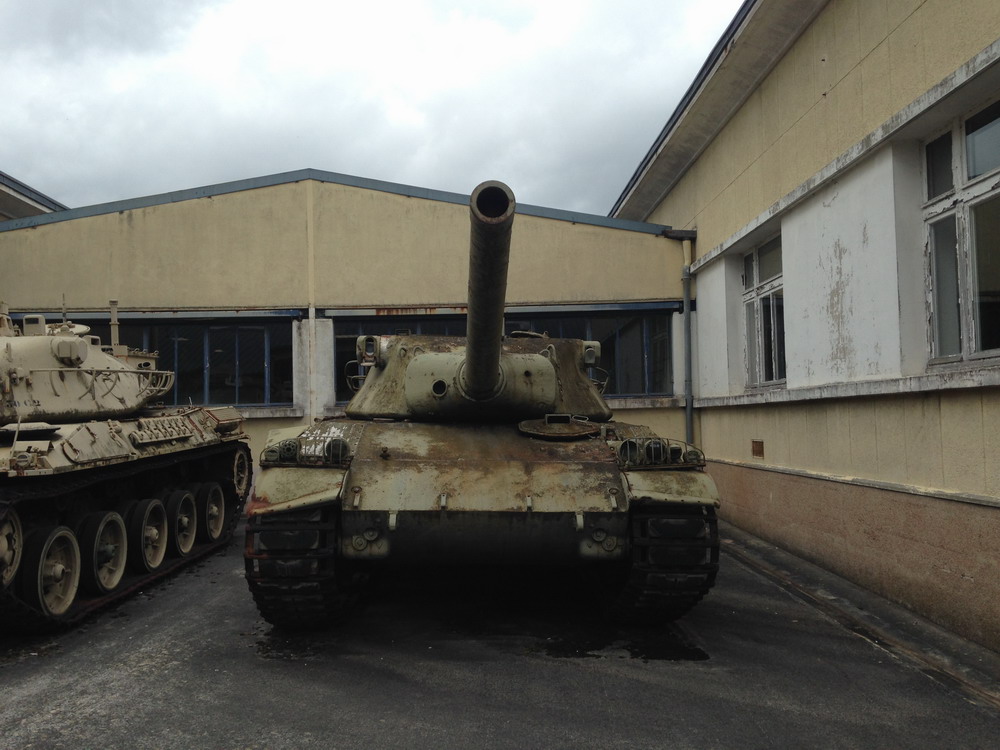
AMX-30A
The initial production version of the AMX-30B weighed 36 tons and had a crew of four (driver, gunner, loader and commander). Of the medium tanks of the era (or, first generation MBTs if you will), it was by far the lightest NATO tank with its weight comparable to the Soviet T-54/55. The armor was steel only and – just like on the prototypes – very light, protecting the crew from 20mm autocannons only (the turret was, for example, only 50mm thick). The frontal hull was well-sloped in order to make as many shots ricochet off as possible. The tank also had two banks of smoke grenade launchers and a NBC protection system.
The turret was based on the earlier AMX-30 prototype designs, but its shape was modified especially at the back and around the mantlet area. Its designation was T.105. The 105mm gun could elevate to +20 degrees and depress to -8 degrees – considering how low the turret was due to its inspiration by the Soviet T-54 design, this was an excellent value. The gun was loaded manually and the tank carried 47 rounds of ammunition. The coaxial weapon was a 12.7mm machinegun, which was later upgraded to the CN 20 F2 20mm automatic cannon, very effective against soft and low-flying targets thanks to its extra 20 degrees of potential elevation. The front of the turret also had a distinctive searchlight mounted – this searchlight could operate in both white light and IR mode.
Mobility-wise, the vehicle retained the excellent properties of the prototype, although the engine was replaced with a Hispano-Suiza HS 110 680hp diesel paired with the 5SD-200D mechanical transmission allowing the tank to reach the speed of 65 km/h. It’s worth noting that the engine is installed in a compact “power pack” configuration, allowing for a replacement of the entire block in 45 minutes.
Even though it was accepted in service essentially in 1963, the real mass-production was only launched in 1966. Over the three decades of its production, more than 3.500 AMX-30 variants were built with France alone accepting 1.355 AMX-30s in service before being retired in 2011.
Naturally, the tank didn’t stay in service for more than four decades in its original form. The tank received a new stabilization gun system in the early 1970s and in 1979, a major upgrade was introduced under the designation of AMX-30B2.
The AMX-30B2 main upgrades included:
- New Fire Control System
- Improved gun mantlet
- Upgraded engine
- Improved suspension
- New APFSDS ammunition
The original FCS with a coincidence rangefinder was upgraded to a model called COTAC (or AMX M581) with a laser rangefinder and a CASTOR thermal camera, significantly increasing the tank’s combat value. The FCS is, naturally, fully computerized. The gun mantlet armor was improved as well (the turret was re-designated to T.105MI).

AMX-30B
The original Hispano-Suiza HS-110 680hp diesel was upgraded to the HS-110-2 model, featuring improved reliability. The horsepower output is actually not quite clear here as multiple (relatively reputable) sources differ from one another, stating either 680 or 720hp, but with the AMX 30B2 manual stating 680hp, we are going to go with that number. The engine was paired with a new semi-automatic SESM ENC200 transmission, compensating together for the increased weight of the vehicle (37 tons). The suspension was also strengthened, as were the shock absorbers. Other smaller upgrades included a new NBC system.
Finally, the tank received new tungsten penetrator APFSDS high-velocity ammunition in 1981. This ammunition is able to penetrate 150mm of armor angled at 30 degrees from horizontal at 5km. There were two sources of the AMX-30B2 tanks. First, 166 AMX-30B2 tanks were built from scratch starting from 1981. Secondly, 493 older AMX-30B tanks were upgraded to the B2 standard.
The AMX-30B2 became the main French MBT until the appearance of the Leclerc and was used successfully by the French in the Gulf War (Operation Daguet) alongside the AMX 10 RC wheeled fire support vehicles. Their deployment in Iraq was successful, if relatively uneventful compared to such large battles as the 73 Easting with the French overwhelming demoralized Iraqi troops without taking any significant losses.
Following the Gulf War, French tank units started to receive the first Leclerc tanks, replacing the venerable AMX-30Bs. However, with the dissolution of the Soviet Union, the same thing happened in France as everywhere else in the west – since the biggest threat disappeared, military budgets got cut, including the tank production. It would therefore take quite some time to replace the AMX-30B completely and since the tank would spend another decade or two in service, there was a need to increase its combat value.
The most obvious weakspot was, obviously, its armor. The tank essentially had none, which was fine for the thinking and tactics of the 1960s, but constituted a massive disadvantage in the 1990s. During Operation Daguet, the French AMX-30Bs would intentionally avoid Iraqi T-72s, as they were considered vulnerable to them. Another serious threat was the general proliferation of ATGMs and RPGs, to which the tank was equally vulnerable.
A partial solution arose in the late 1990 when GIAT developed an Explosive Reactive Armor kit for it called Brenus. This kit consisted of 112 rather small ERA modules called BS G2, weighed some 2 extra tons and provided the additional protection equivalent of 400mm of steel angled at 60 degrees against HEAT rounds. The kit was also resistant against light autocannon fire of up to 20mm caliber. Several AMX-30B2 tanks of the French rapid response units (the ones the most likely to get into the action first) were upgraded with the kit itself with two full battalions of AMX-30B2 tanks converted with fittings to carry this kit if the need arose. This variant of the AMX-30B2 MBT is known simply as AMX-30B2 Brenus, although the name is sometimes written in capital letters, or with double n, depending on the source.
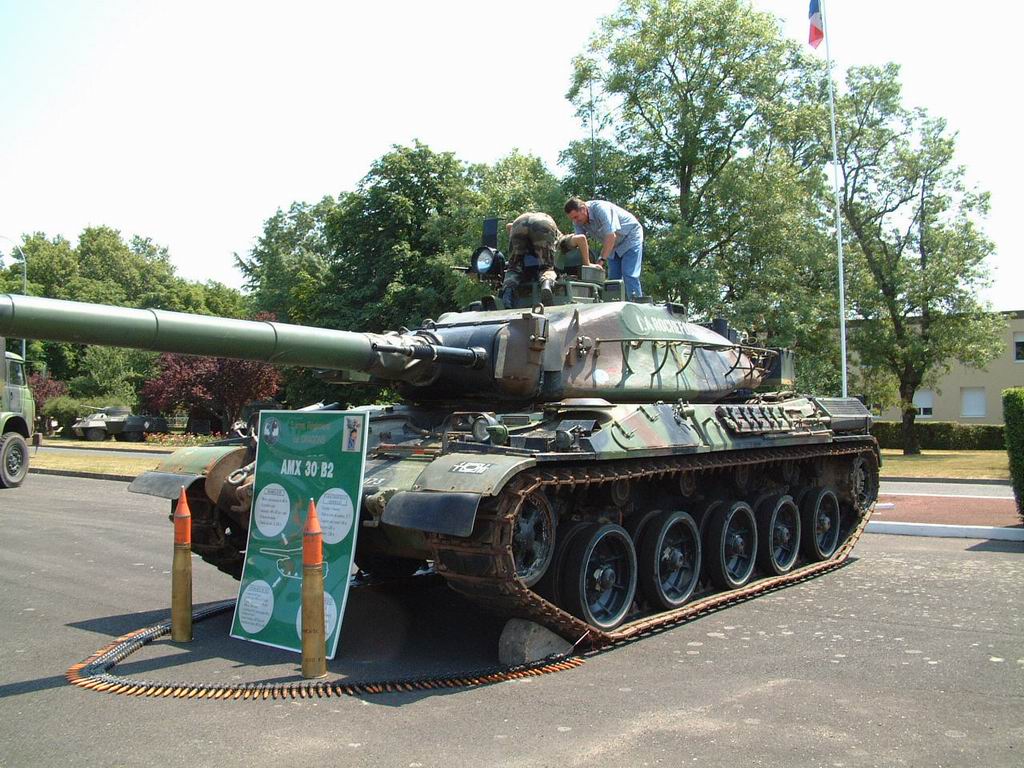
AMX-30B2
The final upgrade step to the AMX-30B2 came in 1998 when it was decided to replace the aging Hispano-Suiza engines that, given their long service, suffered from reliability issues, with American Mack E9 diesel engines producing 750hp. The transmission was retained from the AMX-30B2. Upgraded this way, the tank would serve until its eventual retirement in 2011 after a long and distinguished career. It’s worth noting that the AMX-30B was also successfully exported to several countries and the export models themselves have an interesting history, but that goes beyond the scope of this article. Let us, instead, take a look at what the AMX-30B will be like in Armored Warfare.
For starters, we will be introducing two Tier 4 AMX-30B tanks to Armored Warfare. The basic model of the AMX-30B2 will be a Tier 4 Premium Main Battle Tank (obtainable within the branch for Gold) while the AMX-30B2 Brenus will be a Tier 4 progression MBT. Essentially, both will play roughly the same with the progression version having access to the ERA kit, not a common thing for a Tier 4 vehicle.
But before we go any further in our description, let us, for a moment, return to the French vehicle dealer, Francine De Laroche and the overall design of her vehicle pool. There is an overarching theme present here – and that theme can be best summarized by the word “choice”. This dealer will not only feature multiple vehicle choices on several Tiers, but also the option to configure your vehicles to suit your gameplay by the means of alternative upgrade modules as well as different weapon systems for different roles.
Such is the case of the AMX-30B2 Brenus and its Premium counterpart. In their basic form, these tanks will be, much like the Leopard 1, amongst the lightest and the most mobile in their class with excellent firepower balanced by relatively poor armor protection.

What will make them truly special are the following abilities:
- Players will have two weapon systems available – they will be able to choose between the main 105mm gun and a 20mm autocannon. Their loading times will be independent on one another and the players will be able to switch between them at moment’s notice. Effectively, this means that it’s possible to keep firing with the autocannon while the main gun is loading
- The main 105mm rifled gun (generally comparable to Leopard 1’s L7A3) will have access to a special type of ammo – high velocity HEAT (Obus G) with noticeably higher accuracy and penetration values compared to the other 105mm HEAT rounds
- High reverse speed, allowing for a fast tactical retreat from battle
Additionally, the tanks will have access to special alternative upgrade modules that will modify their properties in order to match the desired playstyle:
- Armor: Choice between more hitpoints or better module protection
- Firepower: Choice between the ability to dish out damage quickly (reload time, aim time and accuracy bonuses) and the ability to snipe better (view range, powerful Obus G HEAT)
- Mobility: Choice between tactical sniper playstyle (camouflage, turret traverse and off-road mobility bonuses) and flat-out mobility improvements (more powerful engine, tougher suspension)
Both versions of the AMX-30B2 will have these options as well as the abovementioned special traits with the only difference between them being the presence of the Brenus ERA on the progression model.
And, last but not least, the OF-40 Tier 4 progression Main Battle Tank, removed previously from the Leopard branch, will be making a turn as an alternative Tier 4 MBT of Francine De Laroche’s branch – and it won’t be the last Italian vehicle to appear in it...
Stay tuned for more info and we’ll see you on the battlefield!




